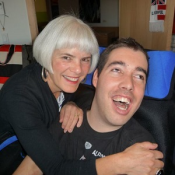 About a year ago, I was working as an art therapist in private practice and I had a 12-year-old client struggling with anxiety and figuring out who she was in the world. I asked her to create a self-portrait—a great exercise for a girl trying to define herself. At one point I realized I had never made a self-portrait, at least not since grade school. So I went out, bought a canvas, took a “selfie,” and began my own personal process answering, “who am I?”
About a year ago, I was working as an art therapist in private practice and I had a 12-year-old client struggling with anxiety and figuring out who she was in the world. I asked her to create a self-portrait—a great exercise for a girl trying to define herself. At one point I realized I had never made a self-portrait, at least not since grade school. So I went out, bought a canvas, took a “selfie,” and began my own personal process answering, “who am I?”
I began with a light sketch, trying to see myself from the observer view. Then I started painting, layering first in basic colors to assign shadow and light areas. I have a lot of experience painting, but painting a person is definitely challenging. Faces have complex layers of subtle shadows and highlights. I worked layer after layer. Too dark. Too light. Too dark again …
One night I came home and looked at the painting in process and wondered, “Have I gone too far? I just keep layering and layering, will it ever be finished? This painting is getting overworked.” I paused, contemplating this chosen word. That’s exactly what I had created: “overworked Michelle”. Working three jobs and always doing a lot, I was overworked and my self-portrait reflected this state.
This is the beauty of art therapy: even though you’re not trying to do it, your self comes through in the art you create. There I was, “overworked Michelle,” in painting as in life. I didn’t like how she looked … and I didn’t like how it felt to be overworked Michelle, either. At that point, I stopped working on the painting and bought a new, blank canvas of the same size. “Who would I be if I wasn’t overworked Michelle?”
I challenged myself to make the Michelle I wanted to be, my ideal state of being. To avoid overworking the painting again I limited my work time to two sittings. In the beginning, I did not sketch anything, but started with paint on canvas, finding a portrait through color and strokes. Without a photo to reference I was free to make the face, body, and shading however I wanted. The result was a representation of how it feels to be me on the inside.
A few nights previously I had had a powerful dream about a mountain lion and when the hole in the chest appeared in my painting, I knew I wanted a cougar coming from the darkness. But how would I paint a cougar in such a short amount of time? Actually, I had already cut one out of a magazine and it was just hanging on my bulletin board nearby. Should I put collage in my painting?! I’d never done that before!
 I found freedom in creating this painting. All rules went out the window. I could be whoever I wanted to be! This is the truth of life. We create imaginary confines around ourselves that don’t actually exist. With the focus of actually creating the me I wanted to be, I found myself soft and open, vulnerable and dangerous, with strong roots hanging down, looking for soil.
I found freedom in creating this painting. All rules went out the window. I could be whoever I wanted to be! This is the truth of life. We create imaginary confines around ourselves that don’t actually exist. With the focus of actually creating the me I wanted to be, I found myself soft and open, vulnerable and dangerous, with strong roots hanging down, looking for soil.
Art is a powerful medium. It reminds us that we are creators, born to make what we want out of life. Art is an opportunity to ask yourself, who do you really want to be? I practiced what I wanted in this painting, and then my life followed suit. I am no longer “overworked Michelle.” Now I have one job, and it is my passion—the place where I share my heart with others and practice vulnerability and openness. I take care of myself first, every day. I don’t feel overworked, because I love what I do. I continue to draw and paint what I want out of life because, in the very near future, it could all come true.
Michelle Lynn Baker is an art therapist and owner of MBodied Art Studio in Westminster, CO. She teaches art classes to children and adults and runs therapeutic art groups for parents and children. Michelle enjoys the spectrum of art as therapy from learning to healing.

The preceding article was solely written by the author named above. Any views and opinions expressed are not necessarily shared by GoodTherapy.org. Questions or concerns about the preceding article can be directed to the author or posted as a comment below.

 Because I'm Happy! (In Spite of Everything)
Because I'm Happy! (In Spite of Everything) Facing Love: The Difficulty of Loving and Being Loved
Facing Love: The Difficulty of Loving and Being Loved How Therapy Can Transform: A Personal Testimonial
How Therapy Can Transform: A Personal Testimonial

Please fill out all required fields to submit your message.
Invalid Email Address.
Please confirm that you are human.
Leave a Comment
By commenting you acknowledge acceptance of GoodTherapy.org's Terms and Conditions of Use.